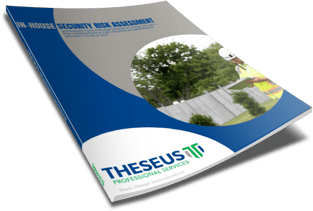2 min read
4 Top Reasons to Consider Facial Biometrics for Access Control (PACS), Plus 1 Bonus Reason
![]() Theseus Team
:
Apr 15, 2023 1:20:15 PM
Theseus Team
:
Apr 15, 2023 1:20:15 PM

When it comes to evaluating the adoption of a new technology for your security program, many considerations must be on the table. To evaluate your options, leaning on an independent security consultant is critical. Facial biometrics have become increasingly popular in recent years as a means of physical access control, offering an alternative to traditional methods such as access cards, fobs, or PIN codes. And now, even the most secure federal organizations are closer to accepting facial biometrics as an equal to fingerprints.
Here are 4 top reasons facial biometrics are an excellent choice for physical access control:
Enhanced Security
Facial biometrics offer a higher level of security compared to traditional access control methods. Facial recognition technology uses sophisticated algorithms to analyze facial features and identify individuals, making it much more difficult to fool the system than with a simple access card or PIN code. And, by eliminating a card credential, a lost card can't be used to gain unauthorized access before it is deactivated.
Convenience
Facial biometrics are incredibly convenient for users. They eliminate the need for carrying an access card or remembering a PIN code, making the entry process much faster and easier. This convenience makes them ideal for high-traffic areas where speed and ease of access are essential. Lower friction in the security process will increase adherence to policies and procedures.
Cost-Effective
Facial biometric systems are becoming more affordable, making them a cost-effective option for physical access control. Compared to traditional methods such as access cards, facial recognition systems don not require issuing fobs or card credentials, saving time and money.
Non-Transferable
Facial biometrics are unique to each individual, making them non-transferable. This means that access cannot be granted to anyone other than the authorized user, which helps to prevent unauthorized access and reduce the risk of security breaches. Pro tip: be sure to implement anti-tailgating measures, like LiDAR, at all sensitive areas.
BONUS REASON
Facial biometrics are now being considered as reliable as fingerprints. The Federal Identity, Credential and Access Management (FICAM) architecture standards must be adhered to by federal government entities. And FIPS 201 is now laying the groundwork for incorporation of biometric identification in future deployments. Read more from SIA about recent and upcoming changes to FICAM and FIPS 201 here.
In conclusion, facial biometrics offer numerous benefits for physical access control systems. Enhanced security, convenience, cost-effectiveness, and non-transferability are just some of the reasons why this technology is becoming increasingly popular. With the continuous advancements in facial recognition technology, it's likely that we'll see even more applications of this technology in the future.
Contact us to discuss implementation of biometrics in your physical access control program >>
 BONUS: DOWNLOAD OUR FREE IN-HOUSE SECURITY RISK ASSESSMENT CONSIDERATIONS GUIDE
BONUS: DOWNLOAD OUR FREE IN-HOUSE SECURITY RISK ASSESSMENT CONSIDERATIONS GUIDE
Security professionals are constantly looking for innovative ways to secure their facility and provide a safe environment within their budget. And, they are also constantly looking for resources to help them achieve that mission while expert advice is hard to come by.
Fortunately, we have released a considerations guide that will help security professionals perform their own in-house security risk assessment.
What's Inside?
This guide is intended to assist you with performing an in-house physical security risk assessment. In many cases, assistance from a third-party expert, like Theseus Professional Services, is required.
Identification of missing or inadequate physical security measures that safeguard assets (people, property, and information) and critical business functions is of paramount importance. The findings of a security risk assessment are used to measure and communicate the level of risk to the organization.
- Process Evaluation
- Threats
- Vulnerability Assessment Highlights
- Electronic Security Systems Considerations
- Site Considerations
- Building Entrances and Exits
- Common Functional Areas
- Building Envelope
- Utilities and Building Services
- Building Systems




